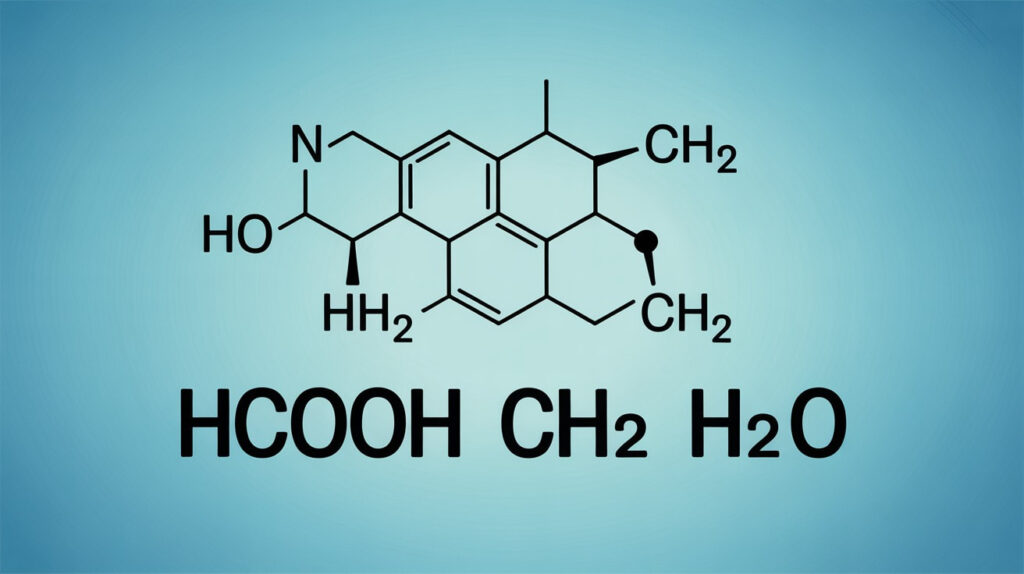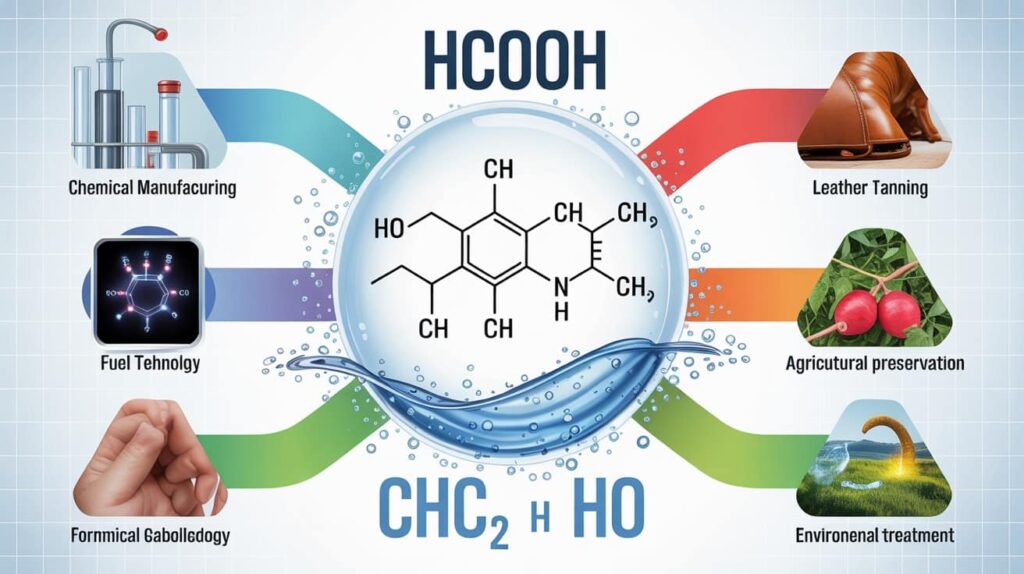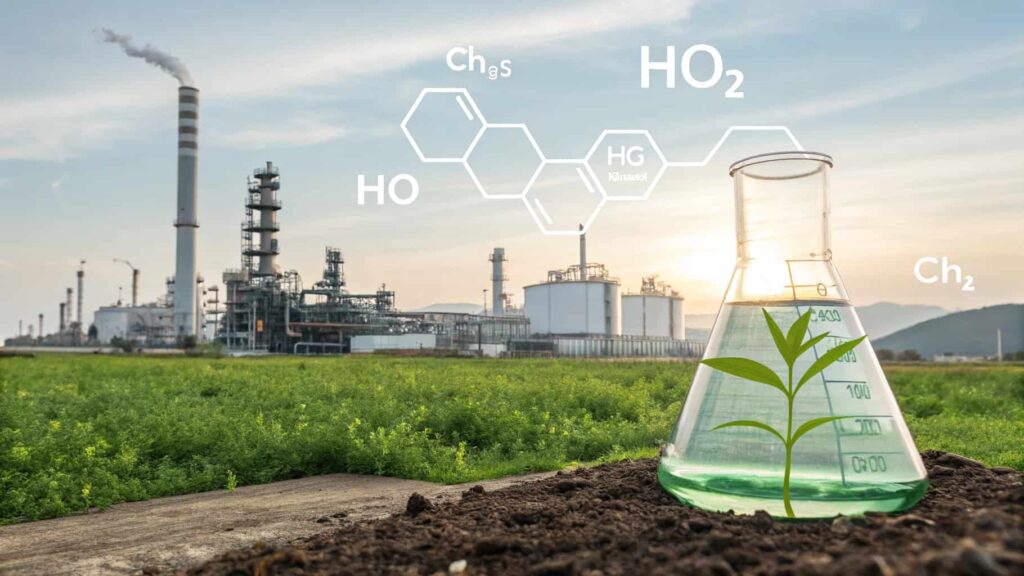HCOOH CH2 H2O – Transforming Industry With Powerful Chemical Processes!
In the fascinating world of organic chemistry, some molecular combinations have a unique and lasting impact on both academic research and industrial processes. HCOOH CH2 H2O a combination of formic acid (HCOOH), the methylene group (CH2), and water (H2O) is one such molecular trio.
Despite their simplicity, these compounds play crucial roles in a variety of chemical reactions that drive important applications in everything from manufacturing to clean energy technologies. Stay tuned with us, we’ll explore the individual components, their roles in chemical reactions, and the diverse applications of HCOOH CH2 H2O.
What Is HCOOH CH2 H2O?
The combination HCOOH CH2 H2O refers to three distinct chemical components, each playing a unique role:

- HCOOH (Formic Acid): The simplest of the carboxylic acids, formic acid is a powerful acid that plays an active role in many chemical reactions. It’s often found in nature and used in a range of industrial processes due to its reactivity and versatility.
- CH2 (Methylene Group): While CH2 alone doesn’t exist as an isolated molecule, it’s a vital linker in larger organic compounds. It often appears as a key part of compounds like formaldehyde (CH2O) and methanol (CH3OH), both of which are crucial in industrial production.
- H2O (Water): The universal solvent, water is more than just a medium for reactions. It actively participates in hydration, hydrolysis, and many equilibrium reactions, making it a fundamental part of chemical processes.
Together, these molecules work in various chemical reactions, including esterification, oxidation, and hydrogen release. Let’s explore each component and its significance in the HCOOH CH2 H2O system.
What Are The Roles Of The Components In The HCOOH CH2 H2O System?
Formic Acid (HCOOH):
Formic acid is one of the simplest carboxylic acids, consisting of a single -COOH group attached to a hydrogen atom. It is highly reactive and plays a crucial role in many organic reactions. Due to its ability to donate protons (H⁺), formic acid is often involved in acid-catalyzed processes, including esterification, oxidation, and decarboxylation.
Methylene Group (CH2):
The methylene group (CH2) doesn’t typically exist as an isolated molecule but is instead a part of larger organic compounds. It can act as a bridge between atoms, enabling the formation of new compounds like formaldehyde (CH2O) and methanol (CH3OH). This functionality makes the methylene group a versatile building block in chemical synthesis.
Water (H2O):
Water is far more than just a solvent. It actively participates in many chemical reactions, including hydration, hydrolysis, and equilibrium shifts. In the case of HCOOH CH2 H2O, water influences the reaction conditions, including solubility, reaction rates, and the overall formation of products.
What Are The Key Reactions Involving HCOOH CH2 H2O?
Esterification:
One of the key reactions involving HCOOH CH2 H2O is esterification. When formic acid reacts with methanol (derived from the methylene group, CH2), an ester is formed. This reaction is reversible and produces water as a byproduct.
Example Reaction: HCOOH+CH3OH⇌HCOOCH3+H2OIn this process, the methanol reacts with formic acid to produce methyl formate (HCOOCH3) and water. This esterification reaction is common in the synthesis of various esters used in solvents, fragrances, and flavors.
Formaldehyde Generation:
Another important reaction in the HCOOH CH2 H2O system is the production of formaldehyde, a key industrial chemical. Formic acid can decompose in the presence of methylene derivatives, producing formaldehyde.
Example Reaction: HCOOH→H2O+CH2OThis reaction, often facilitated by heat or a catalyst, produces formaldehyde (CH2O) and water. Formaldehyde is used in the production of resins, plastics, and disinfectants.
Hydrogen Release for Fuel Cells:
Formic acid has also gained attention for its role in fuel cell technology. It can serve as a hydrogen source, releasing hydrogen under controlled conditions. This can be particularly useful for portable fuel cells and energy storage systems. The presence of HCOOH CH2 H2O systems helps regulate the hydrogen release, making it more efficient and manageable.
What Are The Practical Applications Of HCOOH CH2 H2O?

Chemical Manufacturing and Synthesis:
The combination of HCOOH CH2 H2 O plays a key role in synthesizing formaldehyde and methanol, which are vital intermediates for plastics and resins. Water helps control the reaction rate, ensuring more efficient production. This system is integral to large-scale chemical manufacturing processes.
Fuel Cell Technology:
Formic acid in the HCOOH CH2 H2 O system serves as a hydrogen source for fuel cells, offering a clean energy alternative. The combination aids in the controlled release of hydrogen for energy production. This has significant applications in portable fuel cells for eco-friendly power generation.
Leather Tanning and Textile Industry:
Formic acid is used in leather tanning and textile treatment due to its antibacterial properties. The HCOOH CH2 H2 O system helps preserve materials, enhancing their durability and strength. This application is critical in improving the quality of leather goods and textiles.
Agricultural and Food Preservation:
Formic acid, a component of HCOOH CH2 H2 O, is used to preserve animal feed and perishable foods. It helps prevent microbial growth, extending the shelf life of products. This natural preservative is widely used in the agricultural and food industries.
Environmental and Waste Treatment:
The HCOOH CH2 H2 O system is useful in water treatment and waste management, aiding in the neutralization of pollutants. Formic acid helps break down organic compounds, facilitating the removal of toxins from wastewater. This system contributes to environmental cleanup and sustainability.
What Are The Key Reactions Involving HCOOH CH2 H2O?
The HCOOH CH2 H2 O combination is involved in several important chemical reactions, most notably esterification, formaldehyde generation, and hydrogen release. In esterification, formic acid reacts with methanol (from the CH2 group) to form esters, such as methyl formate, with water as a byproduct.
Additionally, formaldehyde can be generated by the decomposition of formic acid in the presence of methylene derivatives, a reaction facilitated by heat or catalysis. The system is also pivotal in fuel cell technology, where formic acid serves as a hydrogen source, releasing hydrogen for clean energy production. These reactions demonstrate the versatility of the HCOOH CH2 H2 O system in both industrial applications and energy technologies.
What Are The Environmental And Safety Considerations In Using HCOOH CH2 H2O?
Handling Formic Acid Safely:
Formic acid is a corrosive substance and requires careful handling. In laboratory and industrial settings, workers must use proper protective gear, such as gloves, goggles, and lab coats. Adequate ventilation is also essential to prevent inhalation of vapors. Spills should be neutralized using appropriate neutralizing agents to minimize the risk of damage.
Waste Disposal and Environmental Impact:
Reactions involving HCOOH CH2 H2O can generate volatile organic compounds (VOCs), which need to be managed carefully to prevent environmental pollution. Waste disposal protocols should follow local regulations to ensure that byproducts do not harm air and water quality.
How Is HCOOH CH2 H2O Used In Analytical Chemistry?
In analytical chemistry, HCOOH CH2 H2O mixtures are valuable due to their ability to influence various chemical properties, making them useful in several applications:
- Chromatography: Formic acid is often used in liquid chromatography to help separate and identify compounds.
- Titration: Formic acid can be used in titration experiments to determine the concentration of a base.
- Spectroscopy: The presence of HCOOH CH2 H2O can influence the polarity and solubility of compounds, affecting their behavior in spectroscopic tests.
- pH Control: Formic acid helps in controlling the pH of the solution, which is essential for accurate measurements in many tests.
- Solvent for Metal Ions: It is also used in dissolving metal ions in analytical processes, facilitating the detection of metal traces in samples.
What Are The Future Directions For Research On HCOOH CH2 H2O?
Future research on HCOOH CH2 H2O is focusing on more sustainable and efficient applications. One promising direction is the development of bio-based formic acid, sourced from renewable biomass, which could make chemical processes greener. Researchers are also working on improving catalytic systems that utilize HCOOH CH2 H2O to speed up reactions while using less energy.

Another area of focus is the use of formic acid-water solutions in fuel cells, providing a cleaner alternative to traditional energy sources. Additionally, there is growing interest in green chemistry approaches that leverage HCOOH CH2 H2O for more eco-friendly manufacturing processes. These advancements could lead to more sustainable and efficient technologies in energy, chemicals, and manufacturing.
FAQs:
How is HCOOH CH2 H2 O used in fuel cell technology?
Formic acid, combined with CH2 and H2O, serves as a hydrogen source in fuel cells. It provides a clean and sustainable energy solution by releasing hydrogen under controlled conditions, which is utilized for energy production in fuel cells.
What are the safety considerations when handling formic acid (HCOOH)?
Formic acid is corrosive and can cause severe skin irritation and eye damage. Proper safety measures, including protective gear like gloves and goggles, as well as ventilation, are essential when working with HCOOH CH2 H2 O mixtures to avoid exposure and accidents.
How does HCOOH CH2 H2 O impact analytical chemistry?
In analytical chemistry, HCOOH CH2 H2 O mixtures are used in processes like chromatography, titration, and spectroscopy. These systems help in controlling pH, solubility, and polarity, improving the accuracy and precision of chemical analyses.
Can HCOOH CH2 H2 O be used in food preservation?
Yes, formic acid (HCOOH) is used as a preservative in animal feed and perishable foods. It helps inhibit microbial growth, extending the shelf life of food products. This makes HCOOH CH2 H2 O a useful component in the food preservation industry.
How can HCOOH CH2 H2 O contribute to greener industrial processes?
Research is exploring ways to make HCOOH CH2 H2 O systems more efficient, such as by improving catalytic reactions. This could lead to greener industrial processes with reduced environmental impact, particularly in the production of chemicals, materials, and energy.
Conclusion:
The HCOOH CH2 H2O combination is not just a simple collection of molecules; it represents a core concept in organic and industrial chemistry. Whether in sustainable fuel cell technology, chemical synthesis, or industrial applications, these molecules demonstrate remarkable versatility and utility.
As research continues to uncover new uses for this system, its importance in both traditional and emerging technologies will undoubtedly continue to grow.
Also Read: